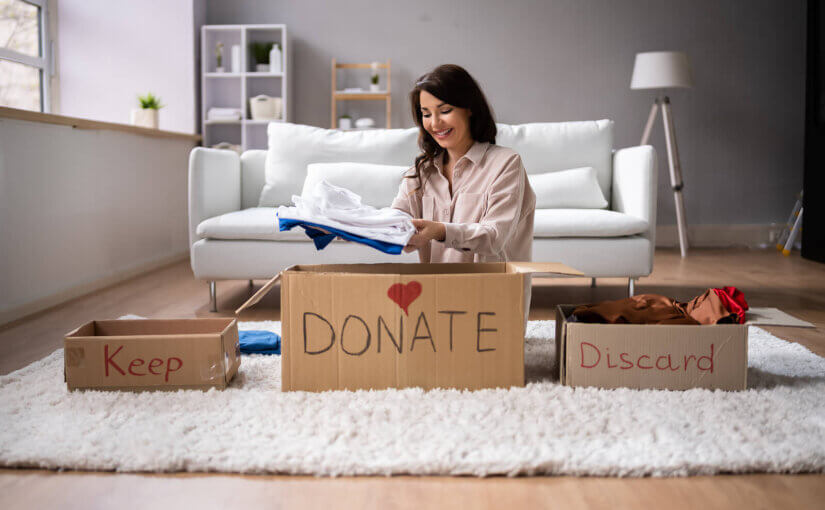We’ve discussed many decluttering methods on our blog, but none with a name as striking as Swedish Death Cleaning. This unique approach goes beyond tidying. It’s about shaping your legacy while you can, sparing your loved ones the emotional and practical burden of sorting through your belongings.
Join us as we explore the origins and philosophy of Swedish Death Cleaning. We’ll guide you through a step-by-step process to use this method in your home and provide a helpful checklist of areas to include.
What is Swedish Death Cleaning?
Swedish Death Cleaning may sound sombre, but it’s a mindful way to declutter your home. Artist Margareta Magnusson introduced the concept in her 2017 book, The Gentle Art of Swedish Death Cleaning. A 2023 television show of the same name popularised it further.
This approach encourages you to sort your belongings, keeping only the essentials. It saves family and friends from the strain of deciding what to keep, sparing them time, money, and distress.
Far from a grim task, fans describe it as ’radical and joyous’. It enables families to have meaningful conversations about death and reframes decluttering as an uplifting, empowering experience — not an overwhelming one.
As the name suggests, Death Cleaning comes from Swedish and Scandinavian culture. Although it’s primarily aimed at those over 65, it can benefit people of all ages. Starting earlier in life allows you to manage your possessions over time, making the task less daunting as you age.
Many young people worldwide are using this method to embrace minimalism, creating homes with only meaningful and purposeful items. It simplifies their lives and helps them focus on what matters, giving them clarity and control.
The benefits of Swedish Death Cleaning
Swedish Death Cleaning offers a wide range of benefits that go beyond tidying up. This method is worth considering because it’s:
- a motivational decluttering framework, inspiring you to take action
- focussed on meaningful essentials
- easing the burden of loved ones
- good for your mental and physical well-being — it helps you sleep better, reduces the risk of asthma and allergies, and relieves stress and anxiety.
A step-by-step guide to Swedish Death Cleaning
Follow these practical steps if you’re ready to use Swedish Death Cleaning to declutter your home.
1. Understand the concept
Before diving in, take time to grasp the purpose of Swedish Death Cleaning. Remember, it’s about simplifying your life by keeping only what is necessary and meaningful. This will benefit your loved ones later.
2. Set clear goals
Define what you want to achieve. Are you decluttering your whole house? Starting with one room? Or are you focusing on a specific category, like paperwork or tools? Examples of goals are:
- creating a calm, minimalist living space
- digitising important documents and shredding the originals
- gifting cherished items to loved ones
- clearing the shed.
Having clear goals — even one — helps focus your efforts. You can always add more as you progress.
3. Create an inventory
List all the areas and categories you plan to declutter. Remember spaces like attics, cellars, and under-stair cupboards.
If you’re focusing on one category, note all relevant storage areas. For instance, if the category is clothing, storage areas might include wardrobes, drawers, coat hooks, and shoe racks.
4. Set a timeline
Establish realistic deadlines to stay motivated and accountable. For example, you might set short-term goals for specific tasks or aim for a long-term deadline to declutter your entire home.
5. Involve family and friends
Open communication is key. Discuss your decluttering plans with loved ones and invite them to help. Reflecting on shared memories during the process can be a wonderful experience.
It’s also a chance to discuss inheritance plans, tell them where you keep important documents, and ask what items they want to keep. Doing so will avoid misunderstandings later.

6. Decide what you’ll do with your belongings
Decide what to do with the items you’re decluttering. Options include:
- Gifting: Pass special items to loved ones.
- Selling: Consider selling valuable items.
- Donating: Send usable items to charity shops.
- Recycling: Recycle whenever possible.
- Discarding: Hire a skip to simplify the disposal of large amounts of waste.
7. Sort through your belongings
Start by removing items from their storage spaces. Then, categorise them using the Red Sticker (Röd Prick) system:
- Red stickers: Items to throw away.
- Green stickers: Items to keep.
- Yellow stickers: Items you’re unsure about.
Place red-stickered items in labelled boxes for destinations like ‘sell,’ ‘donate,’ or ‘discard.’ If using a skip, frequently empty your discard box into it to stay organised.
Return to yellow sticker items later to make a final decision.
Swedish Death Cleaning checklist
There’s no one-size-fits-all checklist for Swedish Death Cleaning. You tailor this method to your personal goals. However, our guide should inspire you, help you get started, and ensure you don’t overlook anything important.
Make sure to check these key areas of your home.
The loft, cellar, and shed
You rarely use items stored in the loft, cellar, and shed, making them a great starting point. Clear out old decorations, broken tools, and forgotten boxes. These take up valuable storage space.
Bedrooms
Bedrooms typically have good storage, like wardrobes, drawers, and under-bed compartments, but they often become cluttered. Declutter your clothes, shoes, accessories, and any random items stored away “just in case.”
The living room
We spend so much time in our living rooms that they often look untidy. Outdated media is a common find. Be honest about what you no longer use — VHS tapes and old records, for instance. Then remove any décor that doesn’t spark joy. A decluttered living room can become a haven in no time.
The kitchen
Kitchens tend to fill up with gadgets and appliances we hardly use. If you haven’t used something in six months, let it go. Clear your worktops, shelves, and cupboards for a cleaner, more functional space.
The home office
Home offices typically become dumping grounds for paperwork and miscellaneous items. Take the time to:
- gather key documents (legal papers, bank account details, etc.) in a labelled folder for easy access by you and your loved ones
- shred and recycle unnecessary documents
- organise your workspace for a productive environment.
Furniture
Furniture is bulky and takes up significant space in your home. Consider removing broken, unused, and pointless items. For example, a spare room bed you don’t need or a dusty, broken recliner. Clearing even one piece of furniture can transform your living space.
Digital clutter
Your digital life matters, too. Make it easier for loved ones to handle your online presence when you’re gone by:
- compiling a list of essential logins (phones, laptops, bank accounts) or granting a family member access to a password manager
- decluttering devices — deleting unnecessary files, photos, and apps from hard drives and cloud storage.
Final thoughts
No matter your age, you can enjoy the benefits of Swedish Death Cleaning. This straightforward decluttering process offers many physical and mental benefits. A clean, organised home with only essentials and items that spark happy memories can improve your quality of life. Plus, you’ll have peace of mind knowing your affairs are in order, sparing your loved ones unnecessary stress when the time comes.
